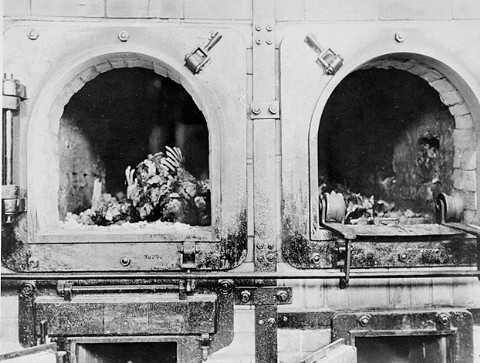How can this photograph be reconciled with revisionist theory on the Holocaust?
How can this photograph be reconciled with revisionist theory on the Holocaust?

Two victims of the Buchenwald concentration camp. Photo was taken shortly after the liberation by U.S. troops.
Date: April 14, 1945
Location: Buchenwald,
Credit: USHMM, courtesy of National Archives and Records Administration, College Park
Copyright: Public Domain
The photograph above taken shortly after the liberation of the Buchenwald concentration camp by U.S. forces actually supports the Revisionist view of the Holocaust rather than the traditional view.
How can that be?
American troops witnessed many horrific scenes like this one of two partially cremated bodies in a crematory. Crematories were the Nazis preferred method of disposing of the bodies of those who perished in the concentration camps rather than burial. Most of the concentration camps contained such facilities.
Buchenwald however is generally acknowledged today to have not had a gas chamber or means of mass extermination. In 1960, Martin Broszat of the Institute for Contemporary History in Munich specifically stated that no one was gassed at Buchenwald.[1] Likewise, Professor A.S. Balachowsky, a member of the Institut de France, declared in 1971, “I would like to confirm to you that no gas chamber as such existed at Buchenwald…” Holocaust writer Konnilyn Feig also conceded in her book, Hitler's Death Camps, that Buchenwald did not have a gas chamber.[2]
In fact, none of the Nazi Concentration Camps liberated by American or other western allied forces are generally agreed by historians to have been part of an extermination program. The terrible scenes witnessed by Allied troops were the result of a complete collapse of the German economy, raging disease, and starvation, due not to a sinister program but rather to the destruction of supply lines to the camps. The Buchenwald museum notes that 13,969 people died in 1945 alone leading up to the American liberation on April 11th.[3] It was these deaths due to overcrowding, disease, and starvation that the Americans witnessed upon their arrival at the camp. Even following the American liberation many hundreds more continued to die due to the same causes as experienced during the final weeks and months of the camp being run by the Nazis. The final count of Jewish dead at Buchenwald is estimated at 11,000.[4] This number is not consistent with that of a program of genocide.
Only the Soviets liberated camps that are said to be part of an extermination program. These were Majdanek and Auschwitz-Birkenau. The size and number of crematory facilities at these camps are consistent with those in the west like Buchenwald and Dachau which are generally acknowledged to have not been part of any such program.
In fact, the evidence which was created at one time and popularly believed regarding Dachau as an extermination center is more complete and better than the Soviet war crimes report presented at Nuremberg that identified Auschwitz as an extermination center.[5] Today it is generally acknowledged that Dachau, like Buchenwald, did not have a gas chamber or any other means of mass extermination.
Notes
- [1]
- Martin Broszat, No Gassing in Dachau, Die Zeit, August 26, 1960.
- [2]
- Mark Weber, Buchenwald: Legend and Reality, Journal of Historical Review, Vol. 7, No. 4 Winter 1986-87, p. 412.
- [3]
- The Buchenwald Museum, http://www.buchenwald.de/media_en/index.html
- [4]
- Ibid.
- [5]
- Translation of USSR-8, Soviet War Crimes Report on Auschwitz, Nuremberg Trial – 6 May 1945, Translated by Carlos W. Porter
Bibliographic information about this document: n/a
Other contributors to this document: n/a
Editor’s comments: n/a
